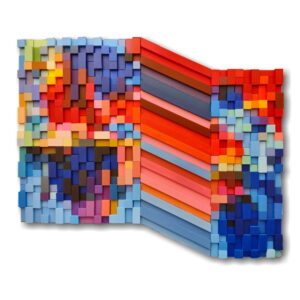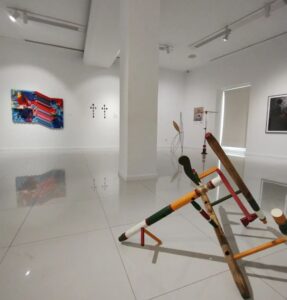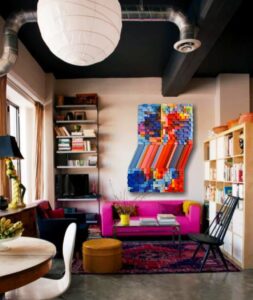The artist Eva Menezz (Madrid, 1981) is currently exhibiting her artwork El Mapa (2022) in the Collective Exhibition of the XXVI Premio de Artes Plásticas, located in the Sala de Arte El Brocense, in Cáceres (Spain). Her artwork was selected from more than a thousand candidate pieces, which were presented with the goal of not only winning, but also being part of the exhibition. The closing of the exhibition will take place on January 5, 2024. Menezz is an artist with a degree in Fine Arts from the Universidad Complutense (Madrid) who has been closely linked to artistic education throughout her professional life. In parallel, her art has been evolving, being more focused on figurative painting and on illustration, with digital editing being important in her work. However, the last years of her career have been focused on full innovation, incorporating three-dimensional materials in her paintings, and transforming them into sculptural paintings, as she aptly names them.

Eva Menezz, El Mapa (Blocks series, Interferencias), 2022, mixed media, acrylic on wood, 149,5 cm x 121 cm x 5 cm, courtesy of the artist
In this aspect, the artwork titled El Mapa (2022), which belongs to her disruptive series Blocks (dedicated to sculptural painting) was conceived in a very particular way— but not exclusive to said piece— which connects with an overflowing creativity on the part of Menezz. It even goes beyond full consciousness, reaching the artist’s unconscious. Sleeping is never completely pleasant if you remember your dreams when you wake up, but on this occasion, this fact is crucial to understanding the conception of her work El Mapa. A mixture of dreams and thoughts produced while awake, before beginning to rest, have led to the creation of this piece by Menezz. The regurgitation of sleep-wake images, as the surrealist artist Max Ernst said about his discovery of frottage, referring to the term sleep-wake, began to materialize through sketches that Menezz drew in haste when getting out of bed. Her objective was to prevent them from being diluted in the still dormant memory. Once the work of documenting the emerging idea was completed, she began experimenting, both with drawing and digital work. In her semi-break, Menezz was stunned by an image revealed in her mind: it was an artwork from the Blocks series which fortuitously lost consistency in the hardness of the material. After becoming elastic, the wooden slats remained melted like the clocks of dalinian iconography. This piece by Blocks is, without a doubt, the most dynamic to date, showing a totally new way of composing for our protagonist. Using wooden blocks as a material base, Menezz considered that she could use more elongated, rectangular slats with different heights. Located in the centre of the composition and diagonally, they can differentiate and at the same time connect two homogeneous areas in the artwork. Thus, unity as the basis of aesthetic beauty is broken and the primacy of the regular geometric form—the square—is also fractured; two key features of her pieces.

El Mapa by Eva Menezz in the Collective exhibition XXVI Premio de Artes Plásticas, Sala de Arte El Brocense, courtesy of the artist
It also serves to break, on a visual level, the harmony expected in the square shape so common in her abstract art, with an effect that even leads to the sensation of movement. In short, the piece evokes movement across the diagonal, just as this resource was imposed in classical Greek sculpture, led by Praxiteles, until it became infinitely useful. However, it is striking to incorporate a diagonal, an optical break in a rather flat support – despite the three-dimensionality achieved with the slats also placed at different heights – and which, apart from that, somehow rejects the rules of the art theorist Clement Greenberg when he stated that «to achieve autonomy, painting must, above all, strip itself of everything that it can share with sculpture. […] the essential rules and conventions of painting are at the same time the limiting conditions that a painting must abide by to be experienced as a painting» (Modern Painting, Clement Greenberg, 1960). A painting had to be primarily flat, square or rectangular, but geometrically uniform. Therefore, El Mapa moves more clearly than ever towards sculpture. It is evident that these reasons have served for the jury to select his artistic piece in the contest. Although chromaticity has not been given as much importance here, Menezz chooses it carefully, taking into account both its harmony and the background of the artwork.

El Mapa in alternative diagonal position, courtesy of the artist
Finally, Menezz, despite being an abstract artist, also resorts to allegory. Her artworks always have a meaning behind them, to remember the value of maps and plans to rationalize the environment. El Mapa alludes precisely to the idea of a flat representation of a geographical surface, in this case, particularly versatile, being a layer. The ability to rotate these documents to orient oneelf has a lot to do with Menezz’s artwork, which can be hung horizontally and vertically, acquiring great flexibility; there is no wrong position.
Andrea García Casal
Info:
Collective exhibition XXVI Premio de Artes Plásticas
1/12/2023-5/1/2024
Sala de Arte El Brocense – C\ San Antón, 17, 10003
Cáceres, Extremadura
Spain
www.cultura.dip-caceres.es/xxvi-premio-de-artes-plasticas

is a contemporary art magazine since 1980






NO COMMENT